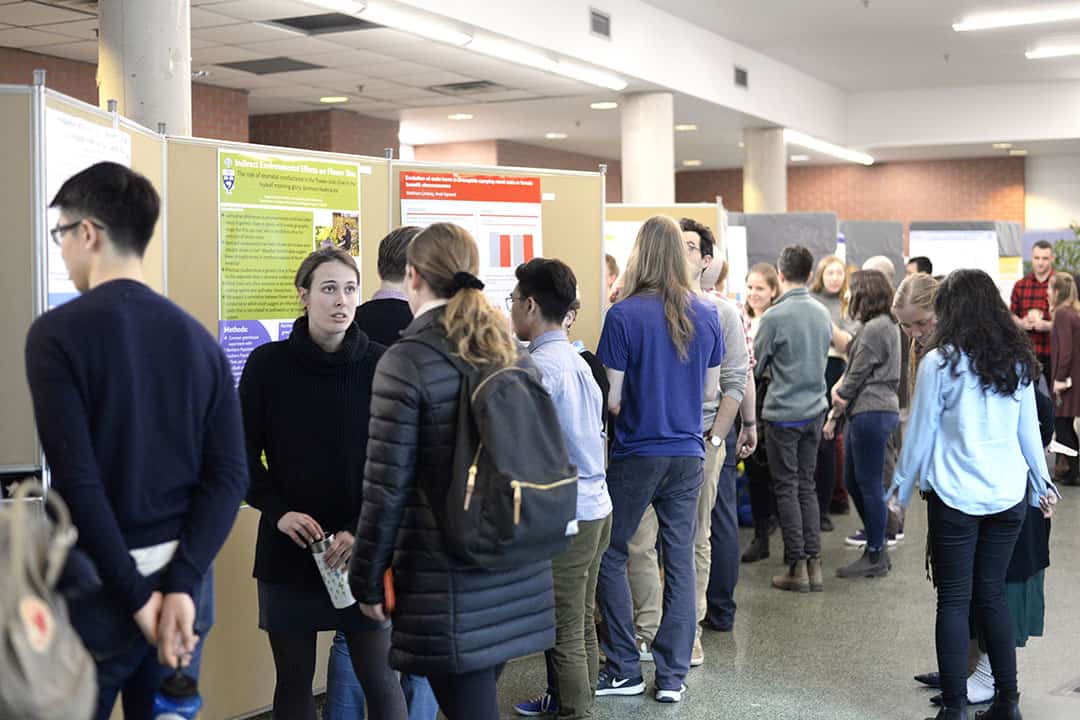Undergraduate students from the Department of Ecology & Evolutionary Biology presented their research on an array of topics, from biodiversity to gene-environment interactions, on April 5 at the Ecology & Evolutionary Biology Undergraduate Research Fair.
Judges selected four winners for a cash prize: Natasha Klasios for research in gene-environment interactions, Elenore Breslow for research in biodiversity & morphology, Joshua Craig for research in mutualism & parasitism, and Edita Folfas for the category of life history ecology & evolution.
Highlights from microplastics research
Klasios, supervised by Dr. Chelsea Rochman, investigated whether wildlife in the San Francisco Bay were absorbing microplastics. Microplastics are tiny pieces of plastic less than five millimetres in diameter which can potentially harm wildlife.
In an interview with The Varsity, Klasios explained that her experiment’s design was to compare the absorbance of microplastics in mussels residing in the bay, to those taken from a marine reserve and left in the Bay for 90 days. Unexpectedly, she found that the transplanted mussels absorbed a greater number of microplastics per individual on average versus the resident species.
Closer analysis revealed that the data was skewed due to specific sites of the Bay having higher concentrations of microplastics, particularly in the central and lower south regions.
Describing the applications, Klasios explained that since her research shows site-specific differences in microplastic absorption by mussels, officials could potentially take samples of mussels from bodies of water over time to monitor microplastic concentrations, and identify “hotspots of pollution” for clean-up.
Jacqueline Bikker, also supervised by Rochman, explained how she analyzed the distribution density and composition of microplastics in the Chesapeake Bay.
Using spectroscopic analysis of surface water samples, she found that the most common type of microplastic pollution consisted of the polymers polyethylene and polypropylene. She also discovered that pollution in the Bay was highest downstream of Baltimore and Washington, D.C.
Highlights from botanical research
Miguel Eduardo Felismino, supervised by Dr. John Stinchcombe, explained how his research found a correlation between the flower size of the ivy-leaved morning glory and a measure called “stomatal conductance.” This is the rate at which carbon dioxide enters and water vapour exits a plant, through small holes in the leaves called stomata.
The findings provided evidence of an abiotic factor that could affect flower size. It does not involve other creatures, unlike known biotic factors that affect flower size, such as the population of local pollinators and the reproductive strategies of nearby plants.
Also supervised by Stinchcombe, Matthew Coffey investigated whether a population of Queen Anne’s lace, or wild carrot, could evolve to develop frost tolerance over time.
While he did not find evidence of evolutionary change over the relatively short six-year timeframe of the study, his investigation showed that developing a seedbank over time through a “resurrection study” design could be a viable way to conduct evolutionary studies.
Julia Boyle, supervised by Dr. Megan Frederickson, investigated whether there are “priority effects” in mutually beneficial relationships between plants and microbes. In other words, she studied whether the order in which microorganisms were introduced to a legume affected the plant’s growth.
Boyle found evidence that the first microbial strain introduced to the plant affected it the most, compared to a subsequently introduced strain. She found that initially introducing a parasitic microbe led to stunted above-ground plant growth, compared to the introduction of a mutualistic microbe.
Even if both strains were ultimately introduced to the plant in identical amounts, Boyle’s observations showed that the order of introduction would significantly affect the plant’s growth.
Highlights from animal research
Cole Brookson, under the supervision of Dr. Martin Krkosek, investigated how two species of sea lice could affect populations of three different species of wild pacific salmon – chum, pink, and sockeye.
L. salmonis is a specialist species of lice that only affects salmon, while C. clemensi is a generalist species that affects all fish. From examining how they affect the salmon species as they swim from the British Columbian coast, he found that the pink salmon species was the most susceptible to both species of lice.
He further found that L. salmonis was more prevalent in the southern Discovery Islands, while C. clemensi was more prevalent around the northern Johnstone Strait. These findings could help guide local communities to manage parasite populations.
Vicki Zhang, supervised by Dr. Locke Rowe, investigated how environmental factors are projected to affect the populations of two ambush bug species in Southern Ontario.
Zhang used Maxent — a machine learning species distribution model — to visualize data. From this data, Zhang created presence-absence maps and discovered that bug population ranges may be contracted in specific areas due to climate change. These maps could help guide future field work on the Phymata americana and Phymata pennsylvanica bug species.
Under the supervision of Sebastian Kvist, Sophia Samuelsson created a “Hitchhiker’s Guide to the Leeches of Canada.” In doing so, she created the first meta-analysis of natural history information for Canadian leech species since the 1970s.
To collect findings, Samuelsson combed through a variety of studies, from how leeches affect turtles, to how leeches carry disease between hosts and respond to lake acidity. She hopes the reference resource may be useful for leech biologists, scientists who study species affected by leeches, and researchers in environmental health.


